Filed under: Analysis, Anarchist Movement, Anti-Patriarchy, Featured, Mexico
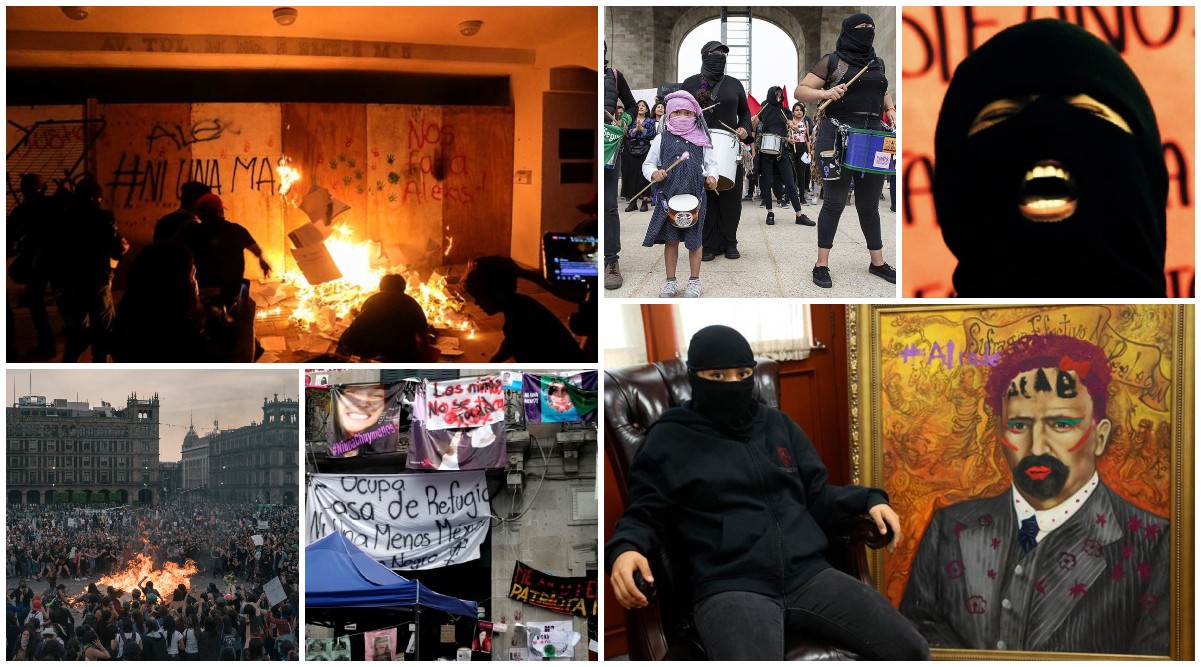
The following article, written by Afinidades Conspirativas and translated by Scott Campbell, examines the recent wave of feminist protests and actions throughout Mexico and the role of anarchism amidst these mobilizations. All footnotes and photo captions are from the original Spanish version, which can be found as a PDF here.
After this article was written, it came to light that those involved in the occupation of the National Human Rights Commission (CNDH), in particular the Okupa Black Bloc, are trans-exclusionary radical feminists (TERF). IGD condemns the transphobic politics of those involved in the Not One Less Okupa. Given the scope and analysis of the article, we have decided to leave it up and encourage readers to keep this information in mind when reading the piece.
“You’re a big shot, drawing on my painting…I hope your action fixes everything”
José Manuel Núñez A., painter of the Madero portrait[1]“If I can’t dance, I don’t want to be part of your revolution”
Emma Goldman“If we can’t be violent, it’s not our revolution”
Manada de lobxs [Pack of wolves]
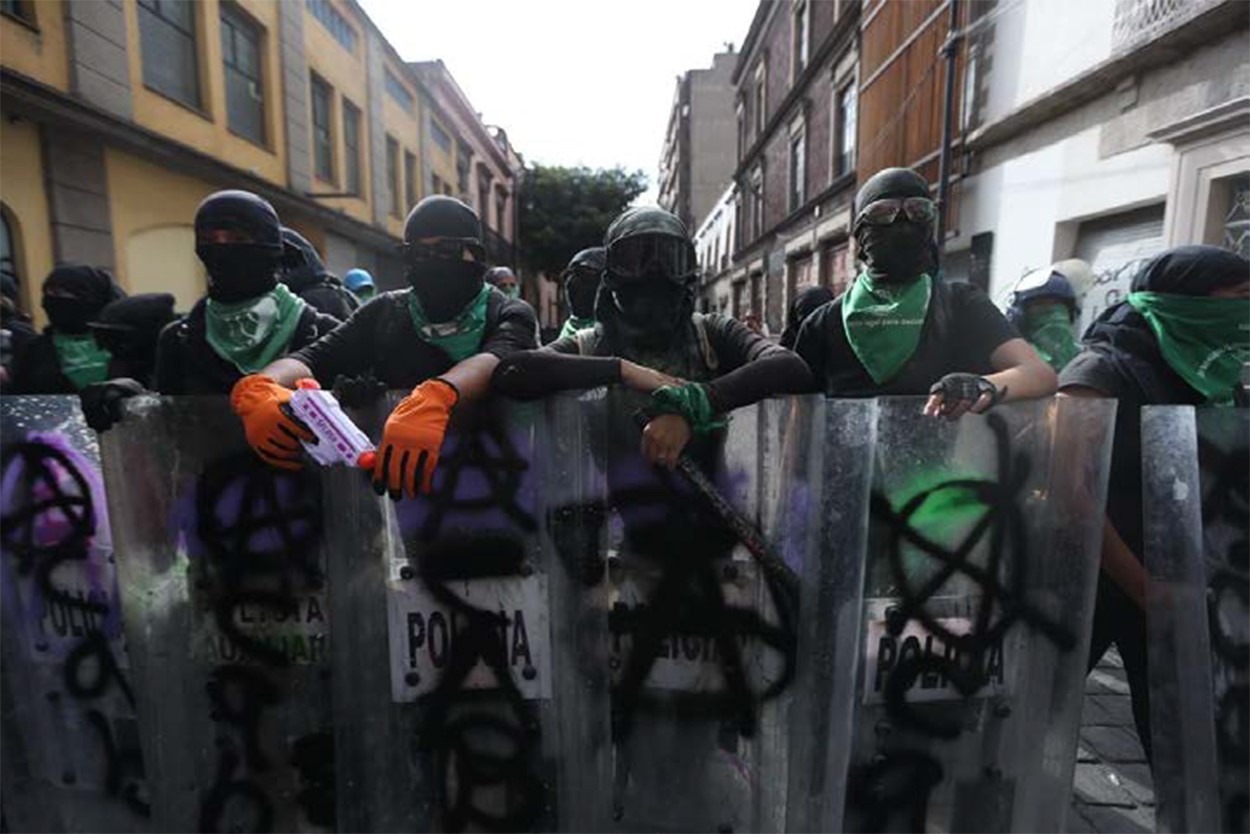
The multiplicity of forms that anarchisms have taken in recent decades leads us to reexamine the tendencies and strategies that are re-configuring themselves or emerging from these forms, as well as their influences on other struggles. Here it is necessary to distinguish a principle held among anarchisms that sets them apart from the liberal or leftist groups that are assumed to be anarchist. We could define this principle as an ethic that, created from an individuality in common, becomes an affront to any form of hierarchical power. As such, to understand anarchism today as an ideology would be a myopia that allows for the development of aberrations such as “anarcho-capitalism” or an understanding of Zapatismo and of many forms of feminism as anarchist. Thinking about the latter, it would be worth remembering Emma Goldman, who ranted against the suffragettes of her time (the first wave of feminism), based on the understanding that freedom could not be achieved at the ballot box. Today’s feminisms are very diverse: there are the reformists with sympathy for the State, with authoritarian and essentialist views about the body; as well as others that are completely liberal, united under the banner of lacking a convincing critique against power; but also among them are some that come together under an anarchist ethic.
Brief Chronology of the Movement
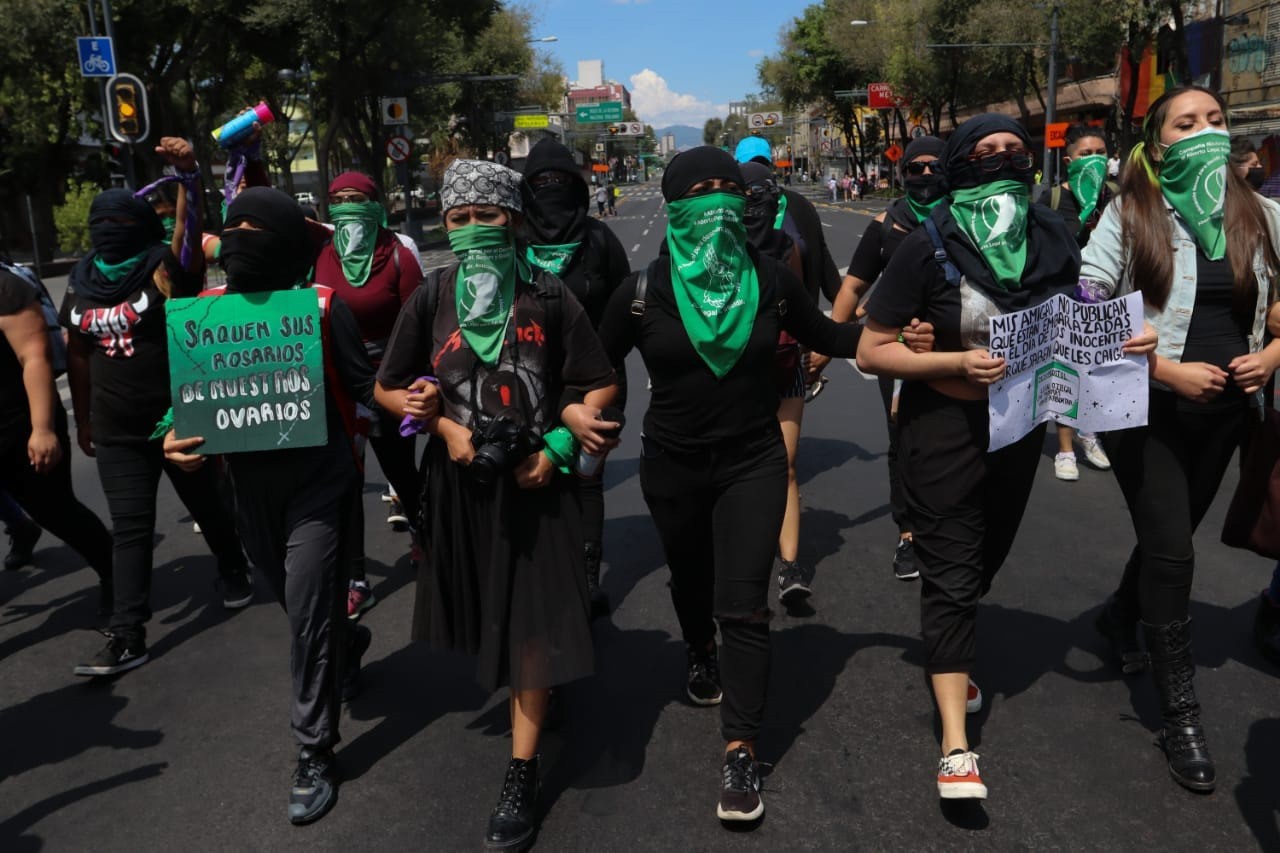
Feminist mobilizations in different parts of the world have intensified. In Latin America, this has been most evident following the eruption of the so-called “green wave” that, in 2018, demanded the decriminalization of abortion in Argentina. Its influence was quickly seen in Mexico. The marches and feminist performances (such as “A Rapist in Your Path”[2]) became trends on social media and in public spaces. In the workplace, in schools, within institutions, and even inside of leftist or anarchist spaces, the anonymous accusation emerged as a political tool to expose any form of aggression understood as “gender-based violence.” An action that destabilized the positions of anarchists, as on occasion the justice of the State was called upon to deal with the aggressors. Even many of the accused became avid legitimizers of the judicial process, demanding evidence or official charges to prove or disprove their aggression. This reduced the possibility of thinking about or creating ways to resolve these processes without relying on the State.
Within this context, we now see a rather narrow link between anarchisms and feminisms. We can’t determine which positions, collectives or individualities should be recognized as anarcho-feminists, as they are in a constant process of consolidation and reformulation. On August 16, 2019, a mobilization was called for by various groups and collectives in Mexico City to demand justice for a young woman who was raped by police officers. The protest ended in an insurrection by women who vandalized public property, and with the burning of a police station.
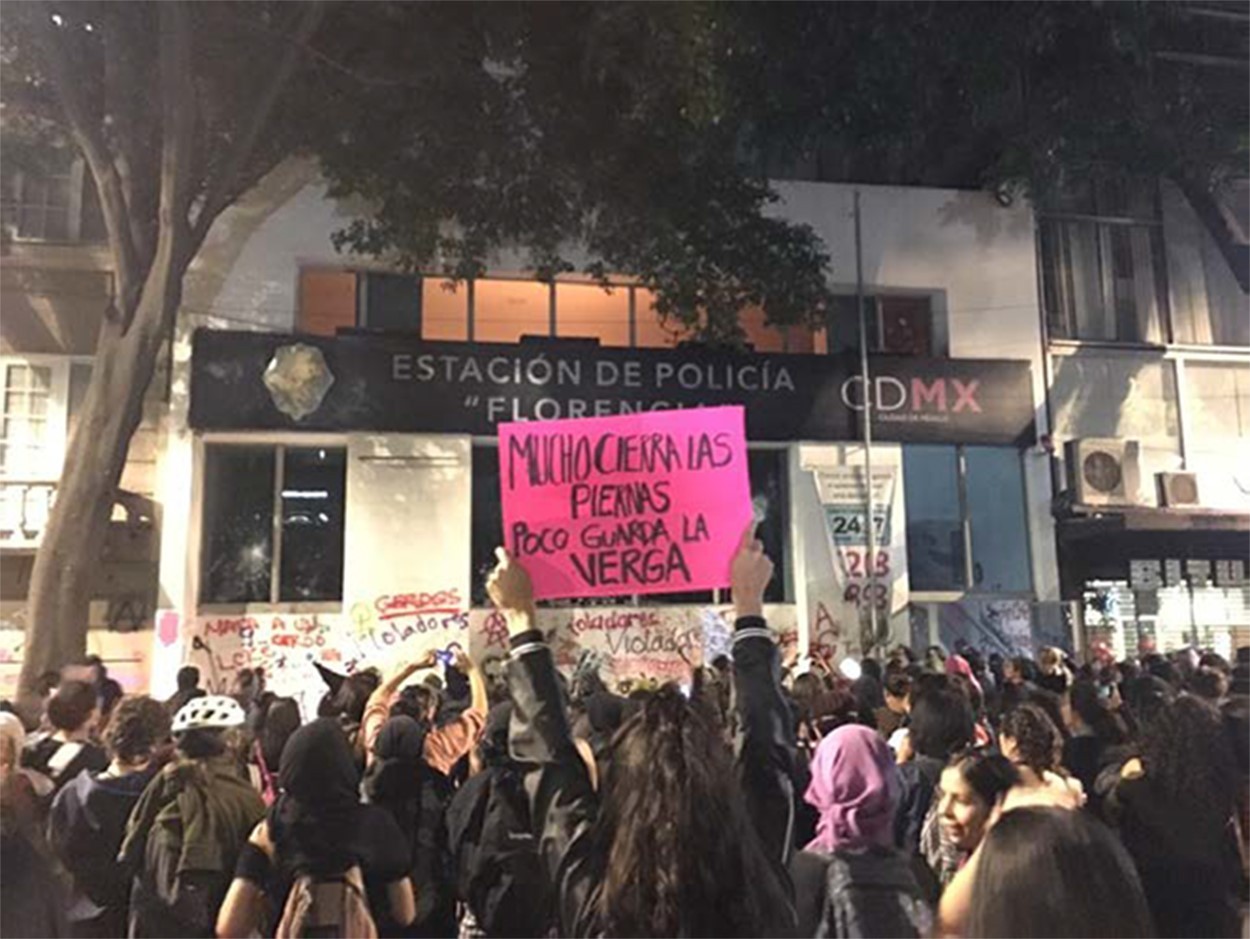
In front of the police station during the protest
For its part, the State made a show of “gender-oriented” repression, typical of the progressive agenda it lays claim to. During the first days of July 2020, an encampment was set up in front of the National Palace by the relatives of murdered women who haven’t found justice in the courts. At the height of the pandemic, the number of femicides and incidents of domestic violence increased. Faced with this, the president maintained his machista and conservative attitude, denying the fact outright and promoting the sale of raffle tickets for the presidential airplane. As was to be expected, various groups were upset by this. So, one year after the burning of the police station, a black bloc of less than 200 women protested again on August 16, being smothered by the heat of 1,600 female riot police who subtly attacked them. Eventually the encampment in front of the National Palace was removed, as it was under constant harassment from the authorities, and the inclement weather didn’t help.
On September 2, 2020, in the offices of the National Human Rights Commission (CNDH), located in the historic city center a few blocks from the National Palace, María Isela Valdez, who had kneeled before the president, asking him for justice for the 2014 disappearance of her son, had an appointment. On this occasion, María Isela, together with Marcela Alemán and Silvia Castillo, mothers of a girl who was raped and a young man who was murdered, respectively, presented themselves to Rosario Piedra, current head of the CNDH. She refused to meet with them because they didn’t bring their case files in the proper format. In response to this rejection, Silvia threatened to commit suicide, and Marcela decided to chain herself to the chair.
Rosario Piedra, the CNDH and the Tentacles of Power
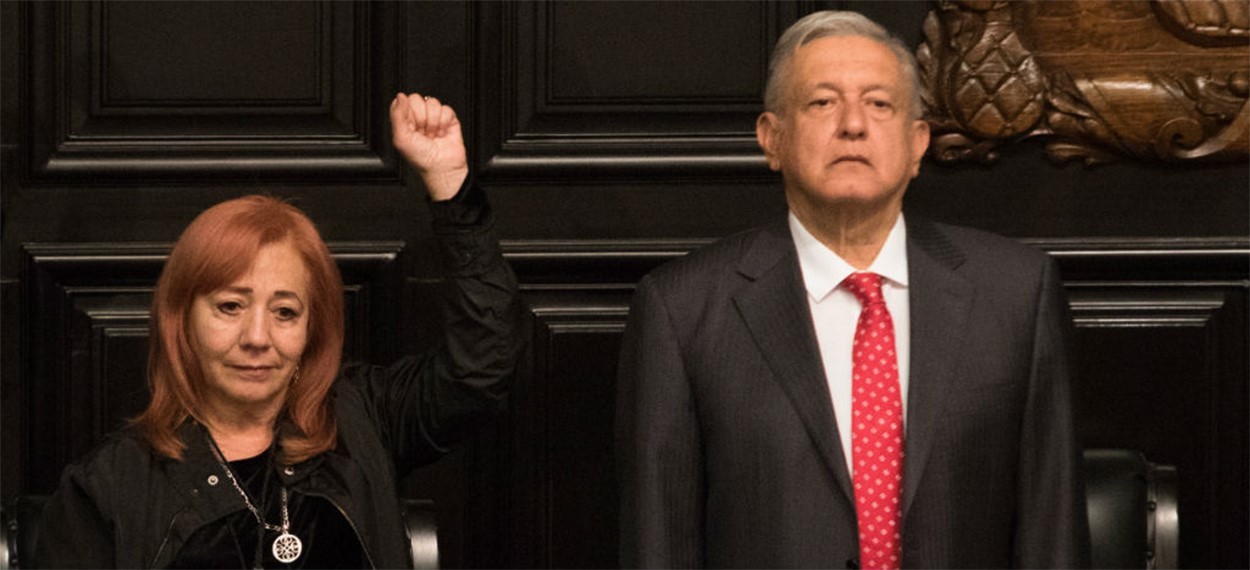
Rosario Piedra being sworn in, next to the president
Well now, who is Rosario Piedra? She is the daughter of activist Rosario Ibarra, one of the first mothers to set out on the search for her son, Jesús Piedra, who was detained in 1974 for supposedly being connected to a killing carried out by the “September 23rd Communist League.”[3] Since then, she has led the search for her son, founding the Committee for the Defense of Political Prisoners, Persecuted, Disappeared, and Exiled (Comité ¡Eureka!). Currently, the sister of Jesús Piedra is the head of the organization that supposedly ensures respect for human rights, anointed by the president for this position. Given this, we should ask ourselves, how does the pain of losing a brother by the hands of the State transform into the desire for a government position? Though one may rebuke us by saying that she is seeking to improve society in the hopes that her pain is not experienced by anyone else, this improvement will never go beyond the parameters suitable to the State or the hands of capital, therefore, we can’t expect anything more than the good administration and management of our lives on their part. As anarchists, no public or government official can offer us the freedom we desire, much less the justice we demand.
The “Not One Less” Okupa: A Needle in the Heart of the State
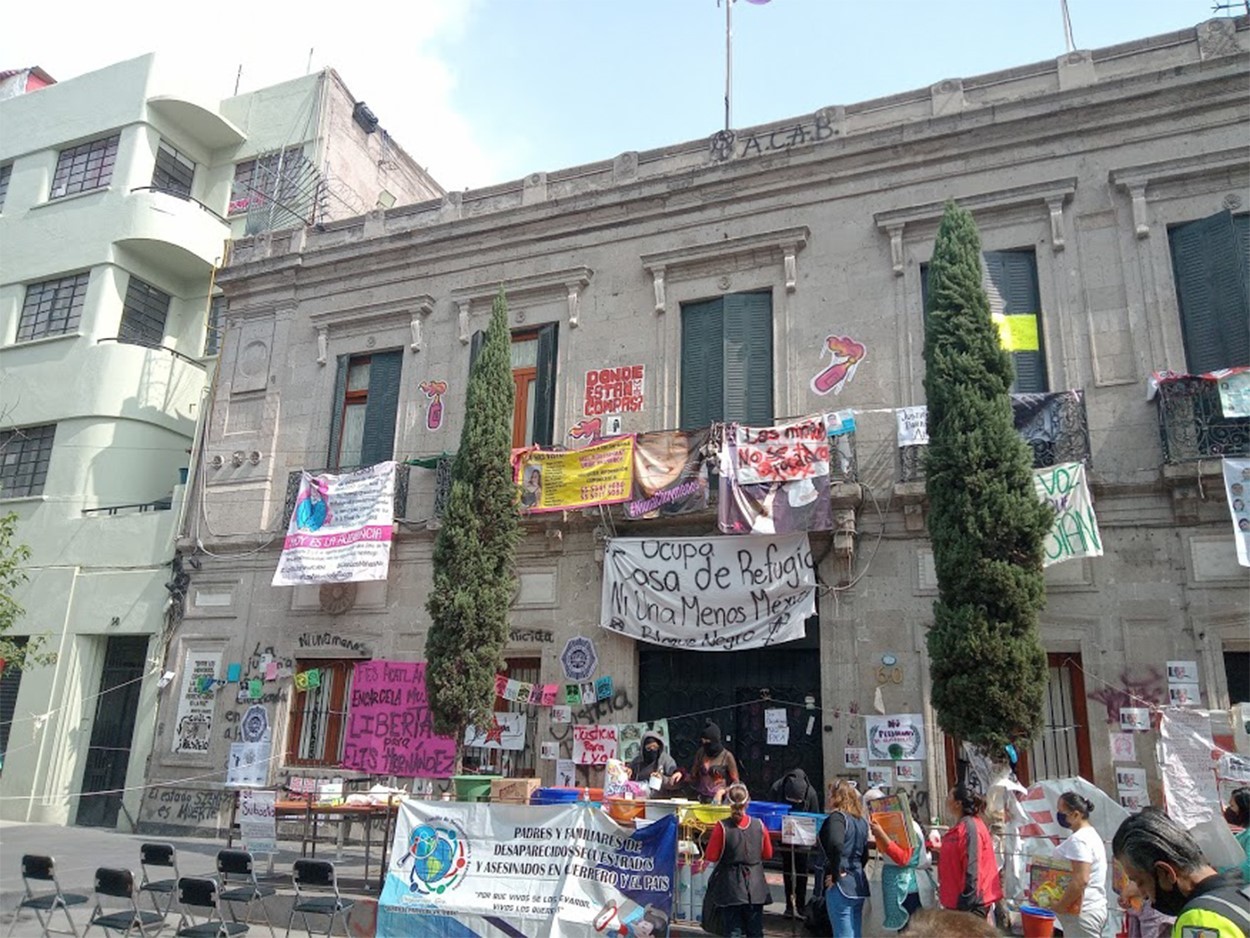
The front of the Not One Less Okupa, located at 60 República de Cuba Street, only a few blocks from the Metropolitan Cathedral, the Ministry of Foreign Relations, and the National Palace
After Marcela Alemán chained herself to the chair, feminists began arriving at the CNDH to support her, with four different collectives coming in and taking over the building, proclaiming it an “Okupa” [squat/occupation/shelter/refuge]. Later, the women who first started the protest left the premises. In the following days, they renamed the location the “Not One Less Okupa,” painting on the walls and on the paintings of historic figures such as Francisco I. Madero or Morelos, an act that enraged the president.
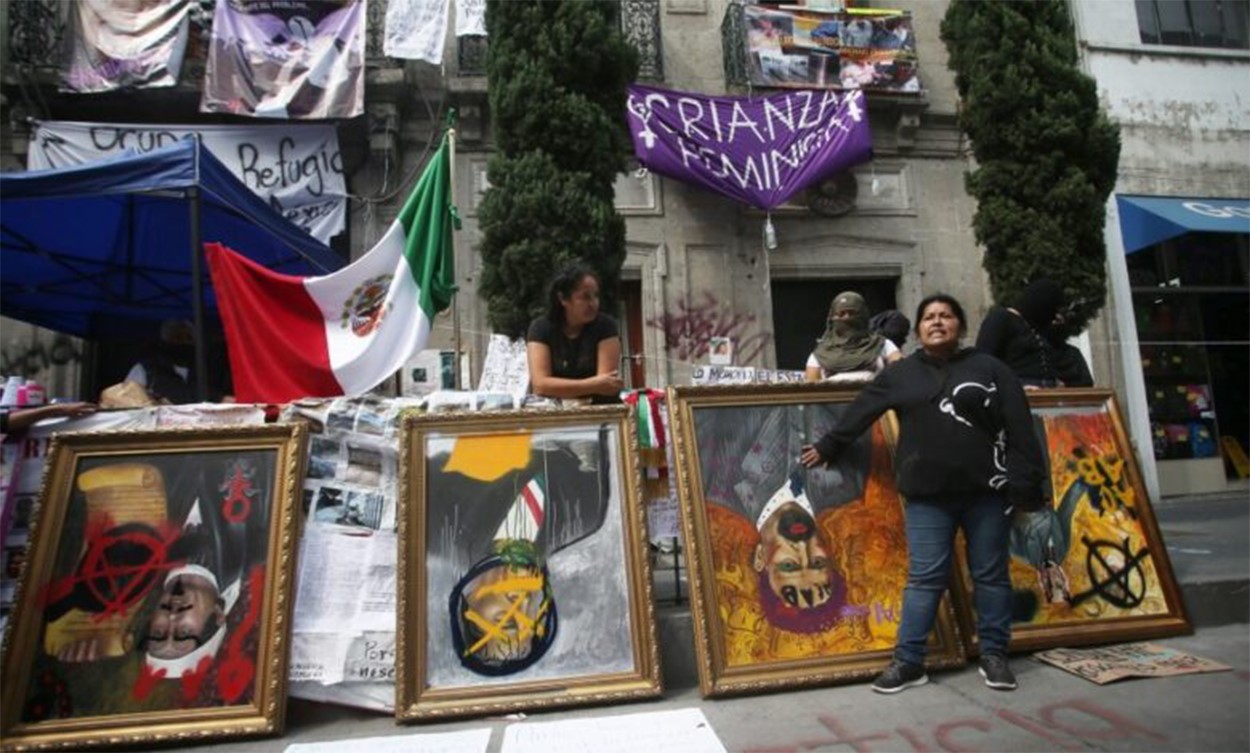
The paintings redecorated by the occupiers. The one being pointed to is of Francisco I. Madero, who has been historically constructed as an apostle of democracy. The president’s anger over this act is based on the fact that his government uses this figure as a moral symbol
This event encouraged more women to take action against CNDH offices in other states. One of them was the takeover of the State of Mexico Human Rights Commission (CODHEM) in Ecatepec on September 10. Seeking to replicate the action, they burst into the building, however, in the early morning of the following day, police arrived in unmarked vehicles to violently remove them from the space and arrest them.[4] In response to these events, the Not One Less Okupa denounced the actions of the government, and on the other hand, some individuals decided to go to the Ecatepec building that same day to vandalize and burn it.
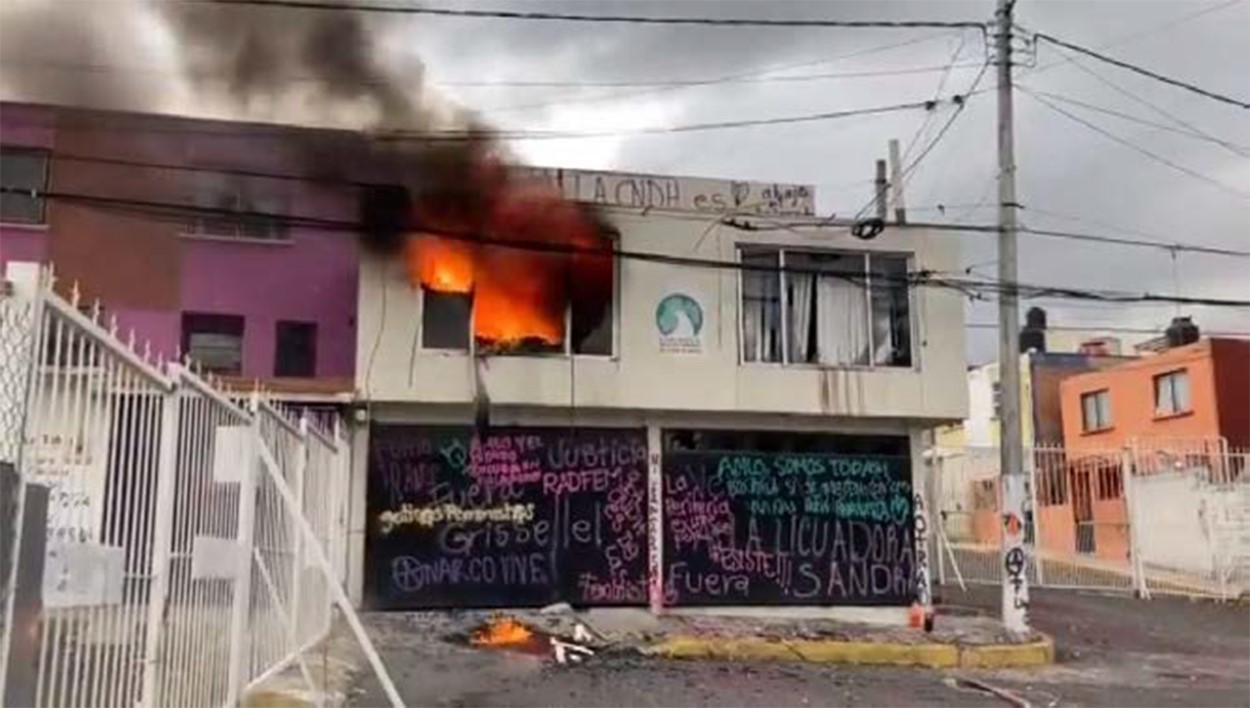
The CODHEM building as it burned
Under these circumstances, on Saturday, September 12, a group of masked women occupied the Chabacano metro station, demanding an end to the police harassment of informal sellers who deliver their products in the metro.[5]
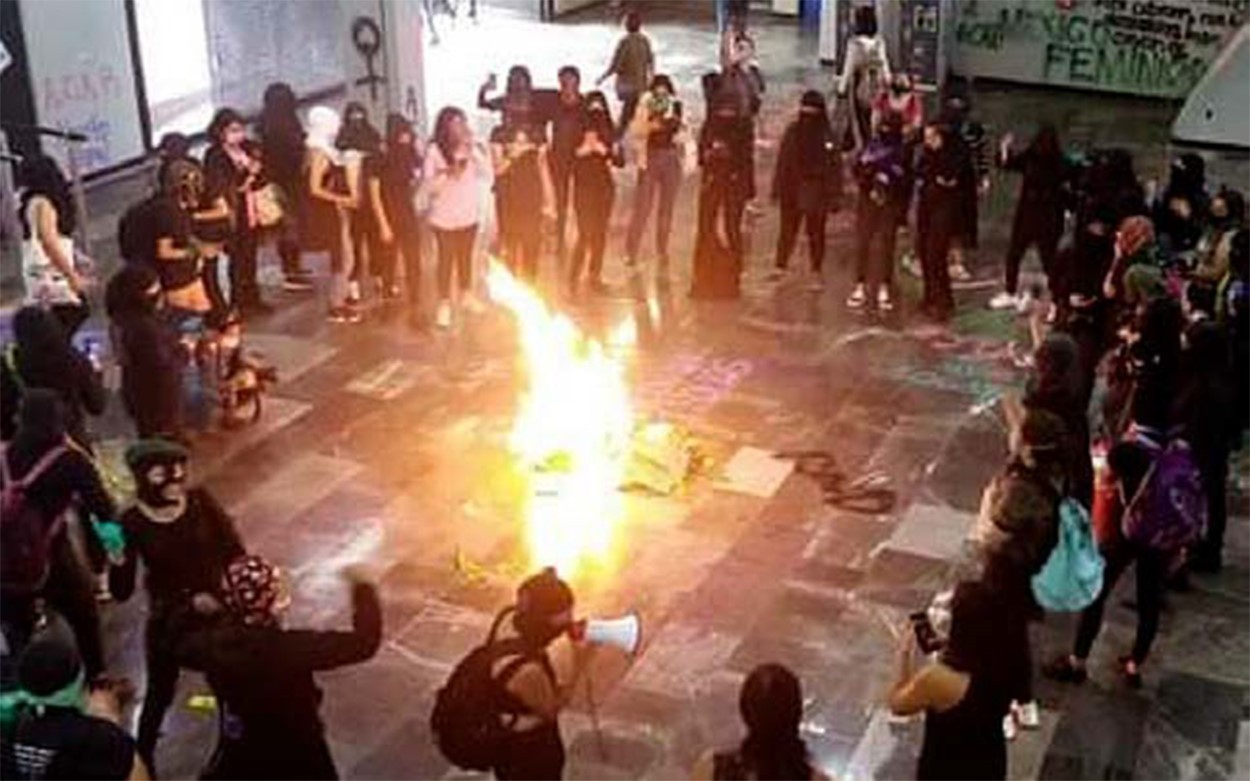
Circle of women during the vandalizing of the metro, in solidarity with those who sell in the metro
On September 14, the “Manada Periferia” [Periphery Pack] held an action on the footbridge in the Valle de Aragón, Nezahualcóyotl, State of Mexico. At the same time, in the Not One Less Okupa, an “Anti-grita” was held, with an artistic and cultural program and a rally with some of the aggrieved mothers. At this event, Yesenia Zamudio, who heads the Not One Less National Front, showed herself to be authoritarian, and the following day various frictions become public that later led to an internal split among factions within the okupa. One of them, called the “Okupa Black Bloc,”[6] was the main one to disassociate from Zamudio as a result of her giving out the names of some compañeras, putting them at risk; for the apparent misuse of funds that had been collected; and to support Erika Martínez, the mother of a seven-year-old girl who was raped.
And although this seemed like a ebbing of the movement, on the morning of September 18, protesters blocked the entrances to University City [at UNAM] and burned property there, damaging two campus security vehicles and graffitied in response to the arrest of Elis Hernández, who was detained last April for her supposed participation in the burning of a building at the Acatlán School of Higher Education (she has since been released). So far, the Not One Less Okupa appears to be secure, inhabited by women, children, and some elderly individuals. Throughout this month, the space has remained open to the general public, with various workshops and events, such as “the little market” (where women can sell various products), but has maintained a position of having only women involved in the space.
Police Repression Beneath the Bosom of the Athenas
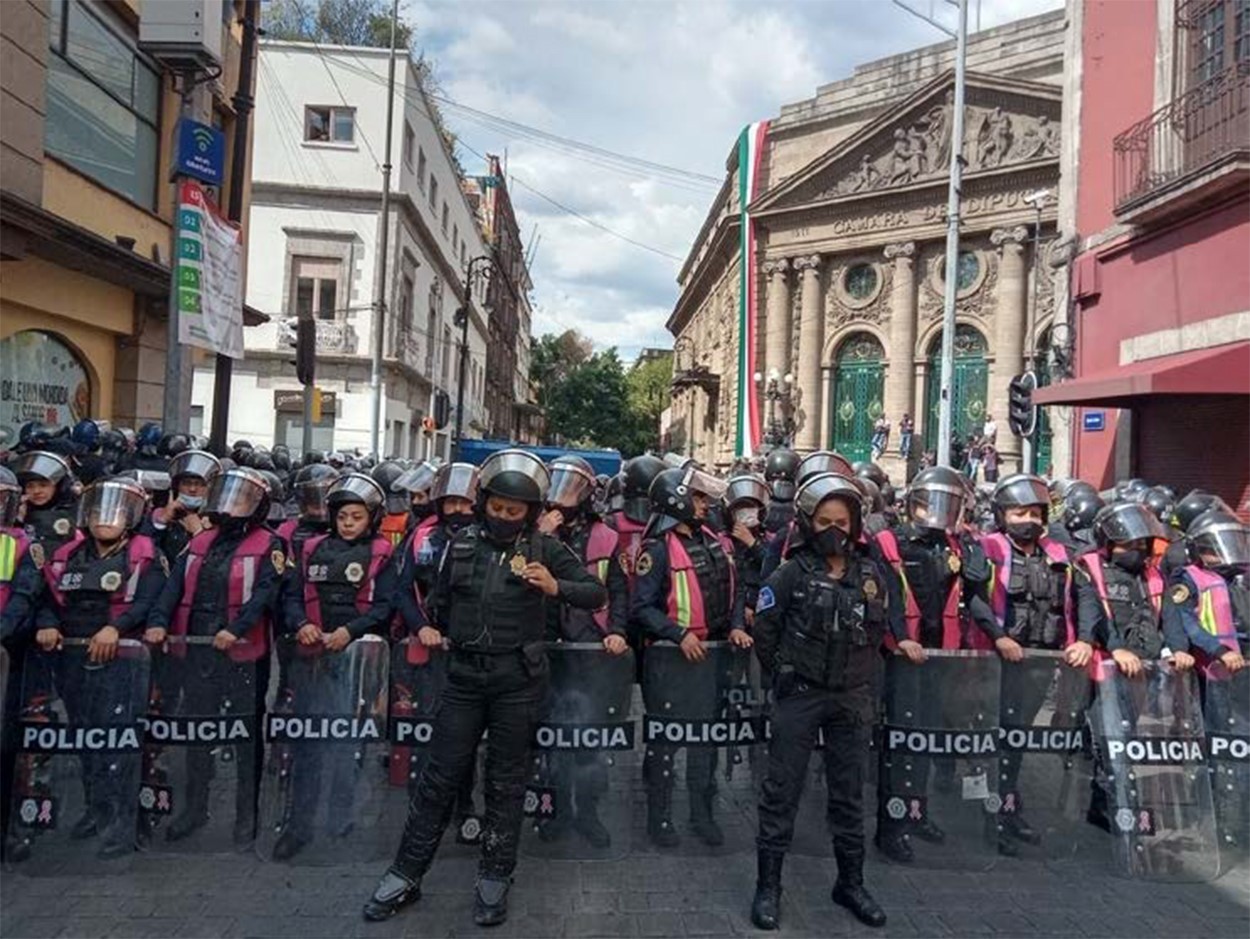
The Athena Squadron during the kettling on September 27
On September 27, a march calling for the decriminalization of abortion in the country brought out no more than 50 women. They departed from the Not One Less Okupa and were kettled by dozens of riot police, primarily women, for at least a couple of hours until they were finally repelled back to the Okupa. It’s worth noting that several blocks in the central area of Mexico City were walled up and protected by police units at several points, in anticipation of the commemoration of the Ayotzinapa disappearances six years ago and the October 2nd march. Since 2019, the calling upon of female riot police by the State to contain or intimidate feminist mobilizations has become a subtle strategy to assuage, for the eyes of the citizenry, the repression that continues, primarily against women.
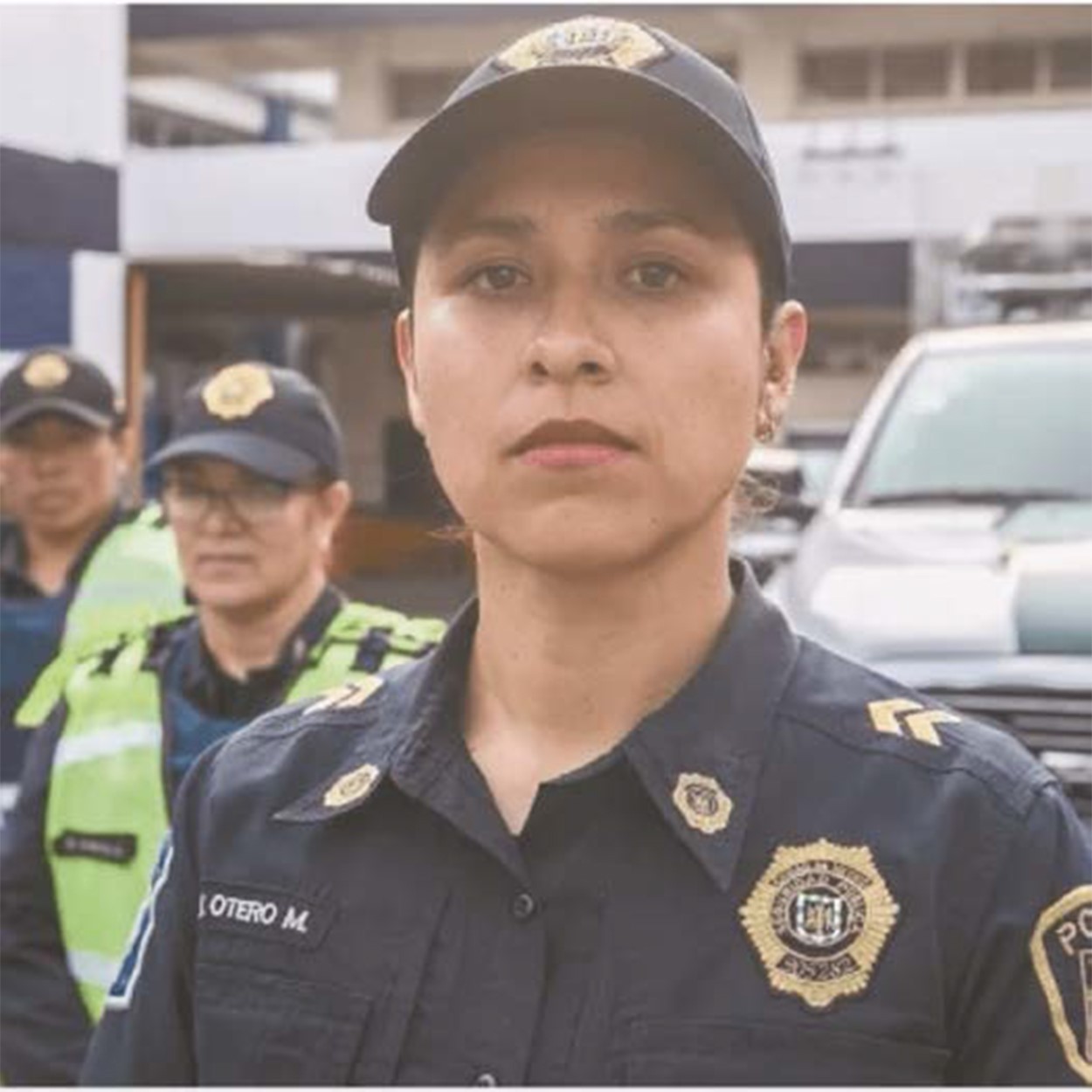
Itzania Otero, Head of the Athenas
For that purpose, in the country’s capital there is the Athena group, part of the Ministry of Public Security, headed by Itzania Otero, which has been charged with taking up the baton when the time comes to face off against women’s protests, always accompanied by male police who remain behind them as reinforcements. In other states, this same strategy has also been seen. One would have to be very naïve to think that a policewoman is a lesser evil, however, even among some protesters there are those who look kindly upon the fact that the club is being wielded by a woman and not by a man.
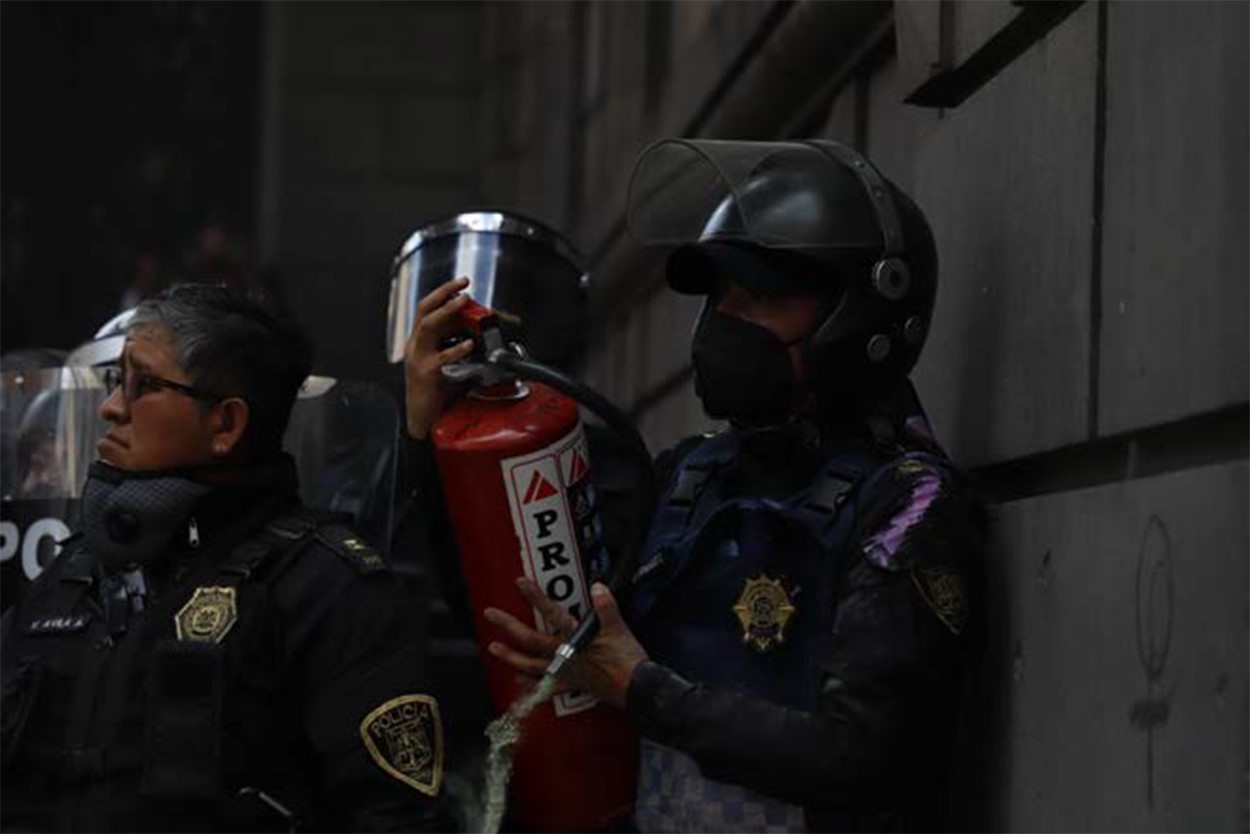
On the left, another commander of the Athenas who has been seen at different protests
The actions that occurred the following day, as part of the Global Day of Action for Legal and Safe Access to Abortion, were overshadowed by the media circus staged by the official media over the altercation between protesters and the Athenas, as one outlet displayed the image of a woman from that group crying. In statements from authorities, they claim that there was no use of tear gas nor other means to contain the protesters. However, dozens of photos show that it was used, along with statements from protesters themselves. So, this Athena seen crying is a result of the gas used by her compañeras and not because she was attacked by a feminist.
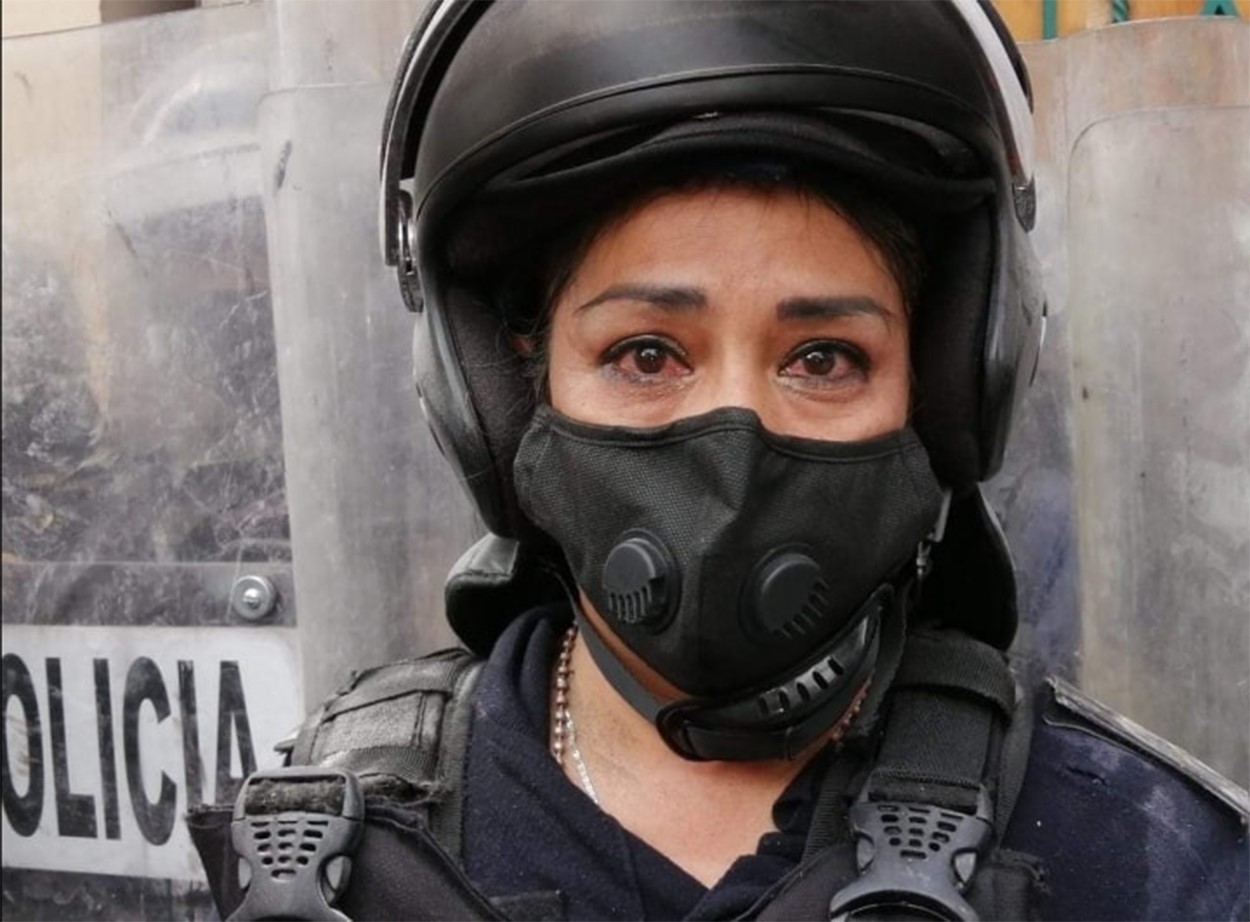
The infamous gaze that brought those of good conscience to call for tougher action against women
Actions in Other States
On September 5, around 40 women who were peacefully protesting were arrested in the state of Chihuahua. On September 10, feminist women occupied and vandalized the offices of the CNDH in Michoacán in support of the collectives in Mexico City. That same day, in Tabasco and Aguascalientes, there were symbolic blockades of CNDH offices. Similarly, in Puebla, protests were held outside the commission’s offices. The following day, women occupied the CNDH building in the port of Veracruz in support of the Not One Less Okupa. On September 13, there were protests outside of the State Human Rights Commission (CEDH) in Monterrey. Along with the anti-grita in the capital, a similar event was held in Tijuana in the Tijuana Cultural Center (CECUT), where they protested and spray-painted slogans. One day later in Guadalajara, a gathering and anti-grita was held in the Rotunda of Illustrious Jaliscienses. Finally, in the early morning of September 18, in the city of Xalapa, the Veracruz Women’s Institute was vandalized. To date, more acts of this type have occurred throughout the country.
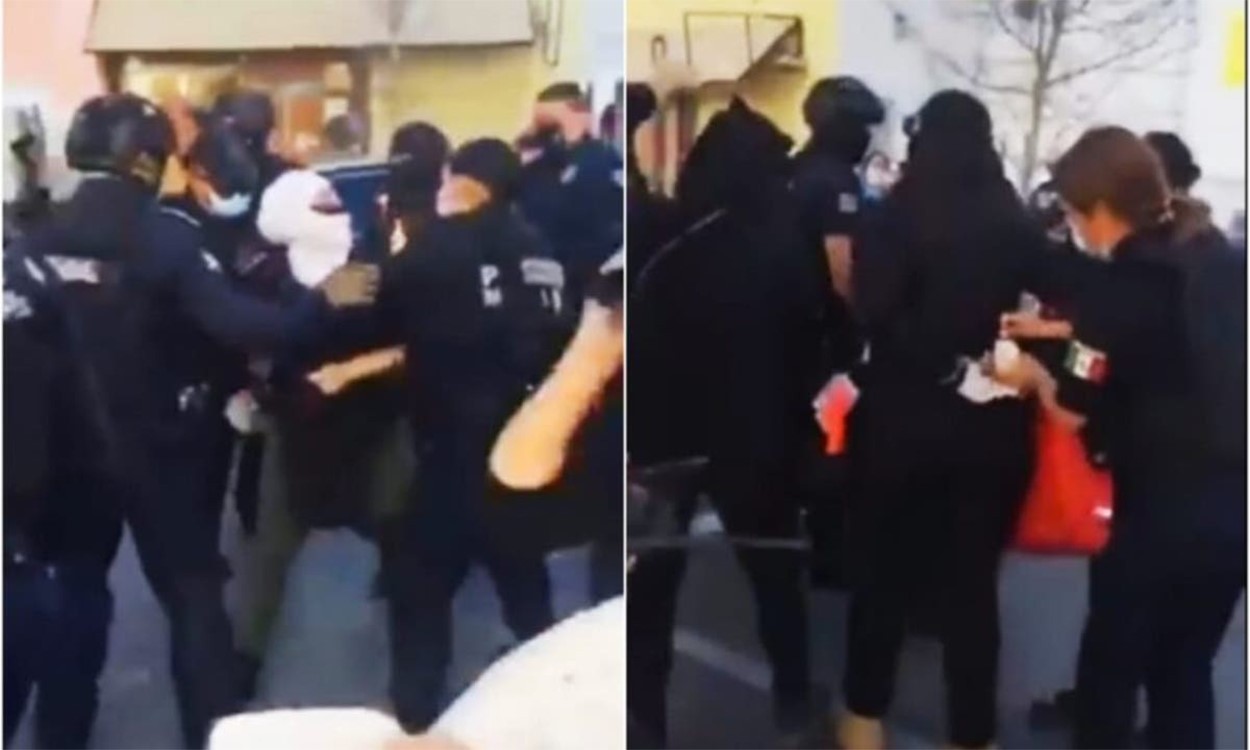
Police arresting women in Chihuahua

The taking of the CNDH offices in Puebla
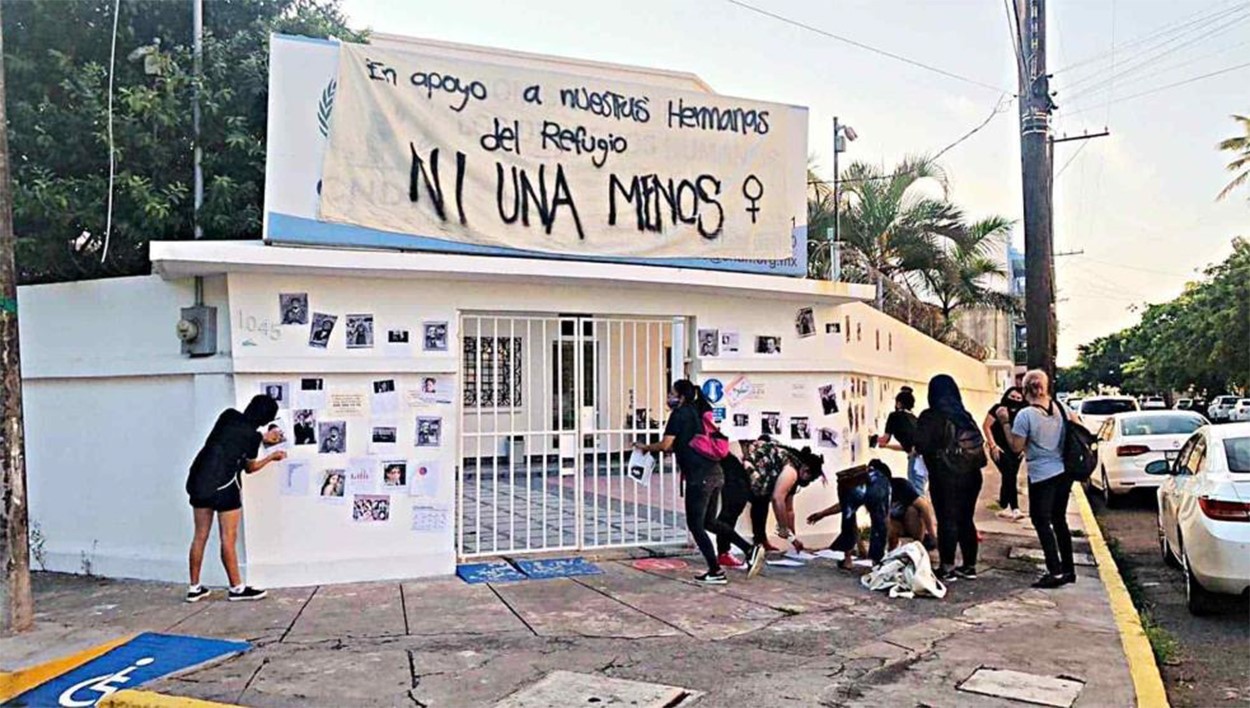
Action at the CNDH offices in Veracruz
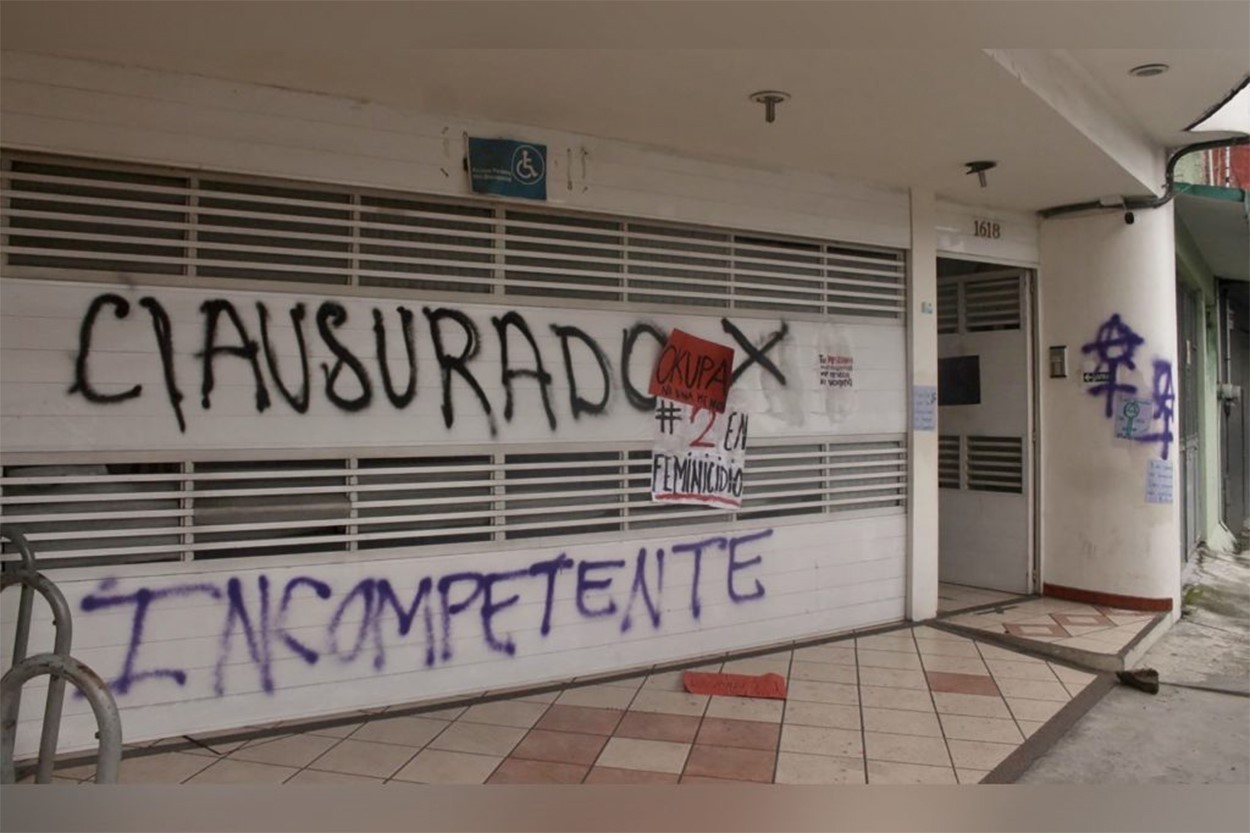
The vandalized Veracruz Women’s Institute in Xalapa
Divergent Paths: Anarchisms, Feminisms, or Anarcho-feminisms
In the 21st century, the influence of different currents of anarchism on various social movements and processes has been noted, which is not to say that these have necessarily been anarchist. David Graeber, the “anarchist anthropologist” who died in early September, commented as well on the positions and influences of movements that articulated anarchist strategies within their repertoire of action. As a result, it’s necessary to not lose sight of this point: that different social groups from the progressive left have appropriated anarchist discourses, practices, and even aesthetics, without truly formulating and proposing concrete action against power, as their true intention is to become a part of it. Creating as a result a pseudo-anarchism, lacking an anti-authoritarian ethos that in the name of a supposed revolutionary transformation generates concessions from power through the institutionalization of demands and the channeling of rage to the gallows of legality, extending the reach of the State and criminalizing those who transcend its logic.
From this perspective, many have given an anarchist reading to the feminist mobilizations in Mexico, where people are dressed in black with green or purple bandanas, demanding rights and clamoring for justice. And yes, while there is a direct influence of anarchist ideas, there are also citizenist ideas. The uproar over seeing women facing off against the Athenas should not blind us to what is happening. On the other hand, the history of anarchism shows us how anarchists from different moments and spaces have connected with social mobilizations that lack anarchist ideals. Here we find ourselves in common cause, the improvement of the individual within a state of oppression, and also here is where a fundamental difference resides, as to how to carry it out: following the parameters of civility and legality of the moment, or challenging them and assuming the risks, not asking for crumbs, but grabbing from the holders of power their peace. Then the question would be, what are the parameters by which we seek these improvements? Could it not perhaps be the case that these improvements would serve to keep us happy within the framework of domination?
In the 21st century, it’s clear that many anarchists have become involved in citizenist processes. But why is this occurring? Is it because anarchists enjoy participating in reformist processes? The answers are complex, but taking up the example of anarcho-syndicalism[7], we can say that as anarchists, amongst ourselves and those in affinity with us, we will always seek freedom in one form or another, be it abandoning the life they offer us or improving the conditions we find ourselves in. This is not definitive, as there will be moments in our lives where we’re inclined more towards one side or another, according to what we feel is necessary. Being a student is something many anarchists have gone through, a moment of learning for some; a waste of time for others, in terms of putting anarchist ideals into action. Joining a social conflict is an experience that has served to revitalize our positions, rethink them, adjust them, or perhaps forget them. So, where do the current feminist mobilizations leave us? Where do we locate ourselves within them? And above all, where do they position us, as anarchists, in either discounting or applauding their struggles?
Those who make up the Black Bloc Collective find themselves in a dangerous scenario that could damage their autonomy and anti-authoritarian perspective. To date, they have been requesting donations of all kinds, but a monetary donation received from businesswoman Beatriz Gasca could call into question their position as anarchists, as this act blurs the entire critique of power that anarchisms entail. Their relationship with her can’t include confronting the totality of the regime of domination, especially as Gasca asked Mexico City mayor Claudia Sheinbaum to respond to the demands of the occupiers.[8] We don’t believe it’s necessary here to explain why a businesswoman can’t be considered part of the anarchist struggle. While some emerge from these social movements convinced that our most solid proposal is conflict with authority, recreating our lives from this mindset, escaping control and projecting a negating happiness; others set out on a one-way trip in the ship of the State. We will see (and have seen) time and again repeated examples of this, such as that of Rosario Piedra. A path that Erika Martínez could end up on if she does not open her eyes, or if her views don’t crystallize into a rupture with the State.
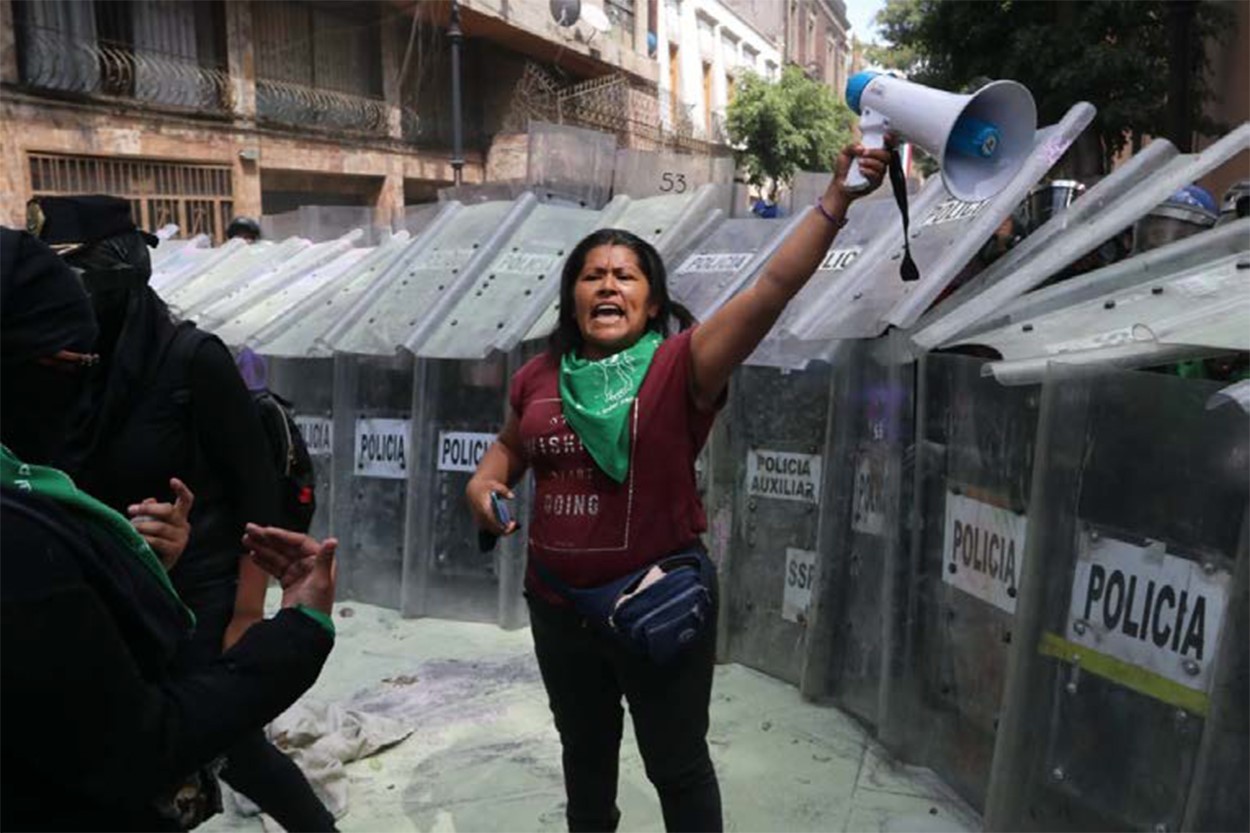
Erika Martínez leading a protest
If, as anarchists, we’re not aware of the limits of our social interventions, the narratives which don’t seek a rupture with power itself will end up marking us and exploiting us. This is very clear regarding the narrative around the criminalization and stigmatization of clandestine abortions by important feminist sectors, claiming that this “freedom” or “right” should be practiced through the State, under rigorous, gender-based surveillance. They defend this bureaucratic victory, assuming a priority that all abortions outside the “feminized” framework of legality are undesirable, unhealthy, or unsafe, to the point of making it “illegal” again. From an anarchist perspective, criminalization must be combated, be it cast in a positive or negative light. Legal or illegal, with or without State resources (and its contributors), abortion will be practiced and, as such, we will defend it. We can’t wipe the sweat from our brows and let out a triumphant sigh upon seeing abortion legalized. Its legalization is linked to current socio-political circumstances, and in the blink of an eye can crumble amidst patriarchal and conservative attacks.
Because of this, it’s important in these rebellious waters to discern how to not get trapped in the nets of those “fishing” for power. The negating, destructive, and rebellious capacities of women’s mobilizations (and not just in the protests, but also in other types of interventions, such as midwives, women’s circles, the recovery of natural medicine, etc.) are those that have put the patriarchal values system in check. Power is disturbed by the tension being created. To turn freedom of choice into a “fact” more than a “right” in every part of our lives is work that should begin in our daily practice: solidarity among women, complicity, combatting machismo, and transgression through direct action is what in reality will transform our individuality and what will make fear change sides. Is that to say that one shouldn’t use the State’s abortion clinics? No! They will be used with audacity and as necessary, without being overwhelmed by the eternal contradiction to which reality subjects us, without accepting the State and capitalist project, without ceasing to plan for the self-management of our struggles and abandoning the quest for a generalized social consensus. Capitalism sells us abortion as one more piece of merchandise, just as it has done with feminism, queerness, veganism, and a long list of positions and activities. It is up to us to ensure that the anarchic knife doesn’t lose its edge.
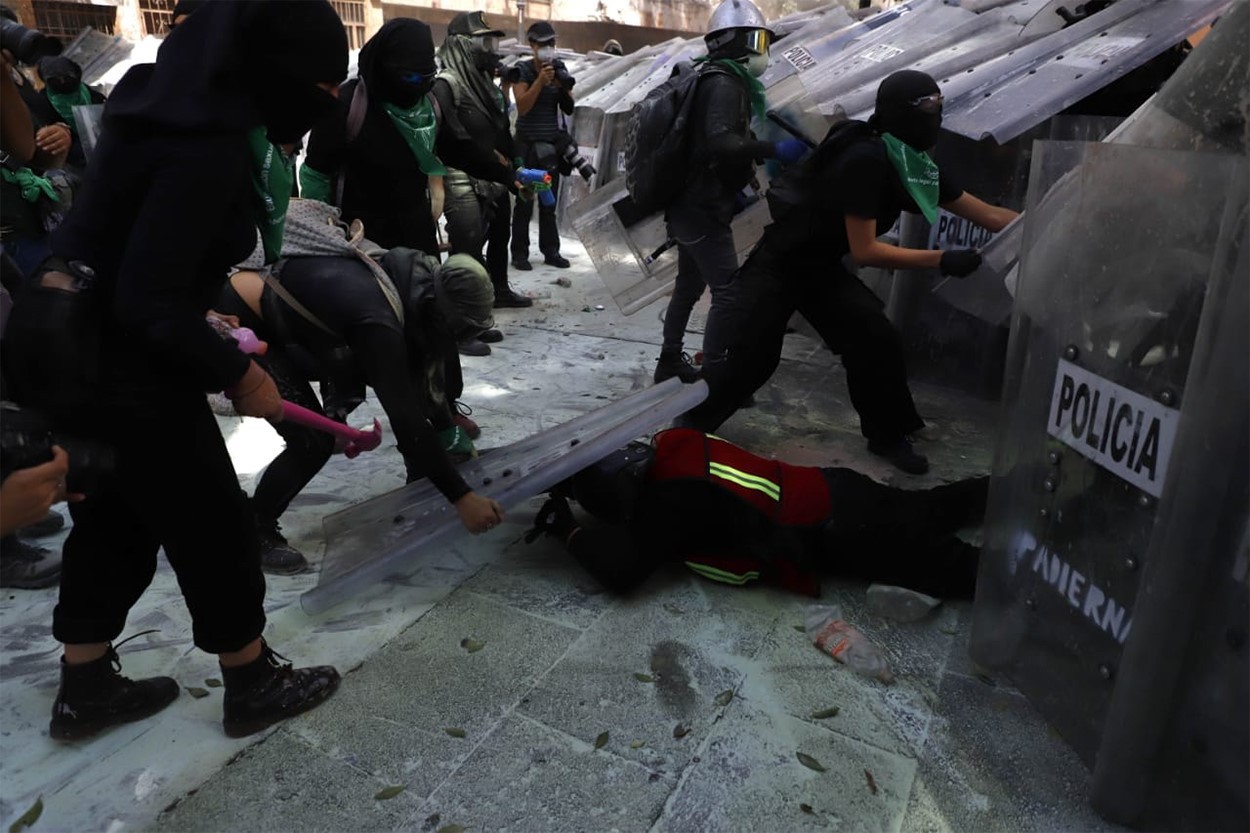
Let fear change sides!
Without leaders or managers!
Without rose-colored worlds to camouflage authority!
Let’s be so free that not even their legality can control us!
Let’s be free and wild!
Mexico, October 16, 2020
Footnotes:
[1] Eventually, José Manuel Núñez had to retract his comment and declare himself in favor of the feminist mobilizations. This, of course, is not because he had reflected upon them, but because of the negative impact his statements had on his image.
[2] The song “A Rapist in Your Path,” that, throughout Latin America and other parts of the world was sung accompanied by a performance, was written by a group of girls from Chile called Las Tesis. Without a doubt, this gave a strong push to feminist mobilizations, nearly becoming an anthem. Its lyrics remind us of the daily violence that falls on femme bodies. However, at the beginning of the year, they were involved in a scandal, where supposedly they formed a political party. They later came out and denied this, although they made it clear their support for women who decided to take that path.
[3] Jesús Piedra, who was within the circles of the September 23rd Communist League, was accused by the Federal Security Directorate (DFS) of having participated in the failed kidnapping of businessman Eugenio Garza Sada, which resulted in the Garza’s death. After this, his parents were arrested and tortured to give up the location of their son. Eventually, Jesús was arrested by the DFS and was never heard from again.
[4] Ecatepec, a municipality in the State of Mexico, is one of the most violent geographies for women. A large number of the murders of women that happen in the country occur in this area.
[5] Given the economic havoc caused by the pandemic, many people have opted to buy and sell items online. As a result, to avoid greater expenses for both those who buy as well as sell, the transactions are carried out in person, using the metro as a meeting place. However, in recent months, police have begun to arrest those doing this, under the absurd argument that it encourages illegal vendors, seeing as it’s the police who are the ones who provide cover or work with the mafias of vendors within the metro stations.
[6] It’s worth remembering that the “black bloc” is a strategy of direct confrontation characterized by informal organization, that is to say, lacking in structure to allow freedom of action for those who comprise it. In recent years, it has received a lot of attention and due to the disinformation of official media outlets, many believe it to be a formal group or organization. However, on this occasion, the group or collective “Okupa Black Bloc” does refer to a grouping organized under that name.
[7] It must be stressed that we are not advocating for the return of anarcho-syndicalism, but we use it as an example of an anarchist proposal that had a specific context and acted under a seditious paradigm that is not currently present, as syndicalism has been perfectly integrated into the system, creating corporativism and the pacification of class struggle. The most up-to-date anarchic perspectives have recognized the centrality of labor as part of the chains that oppress our lives.
[8] This act has played into the political and media strategy of Claudia Sheinbaum, who claims that the women’s movement is being funded by businesspeople, feeding the narrative that the “Fourth Transformation,” led by AMLO and MORENA, is being attacked by the right-wing opposition and that conservatives and businesspeople are financing these movements. This is why there is a pressing need for anarchist activity to intervene with a project and ethics of its own, that in its constant rejection of all authority doesn’t allow itself to be recuperated or instrumentalized by any of the groups fighting for power, be they on the left, right, or center.





